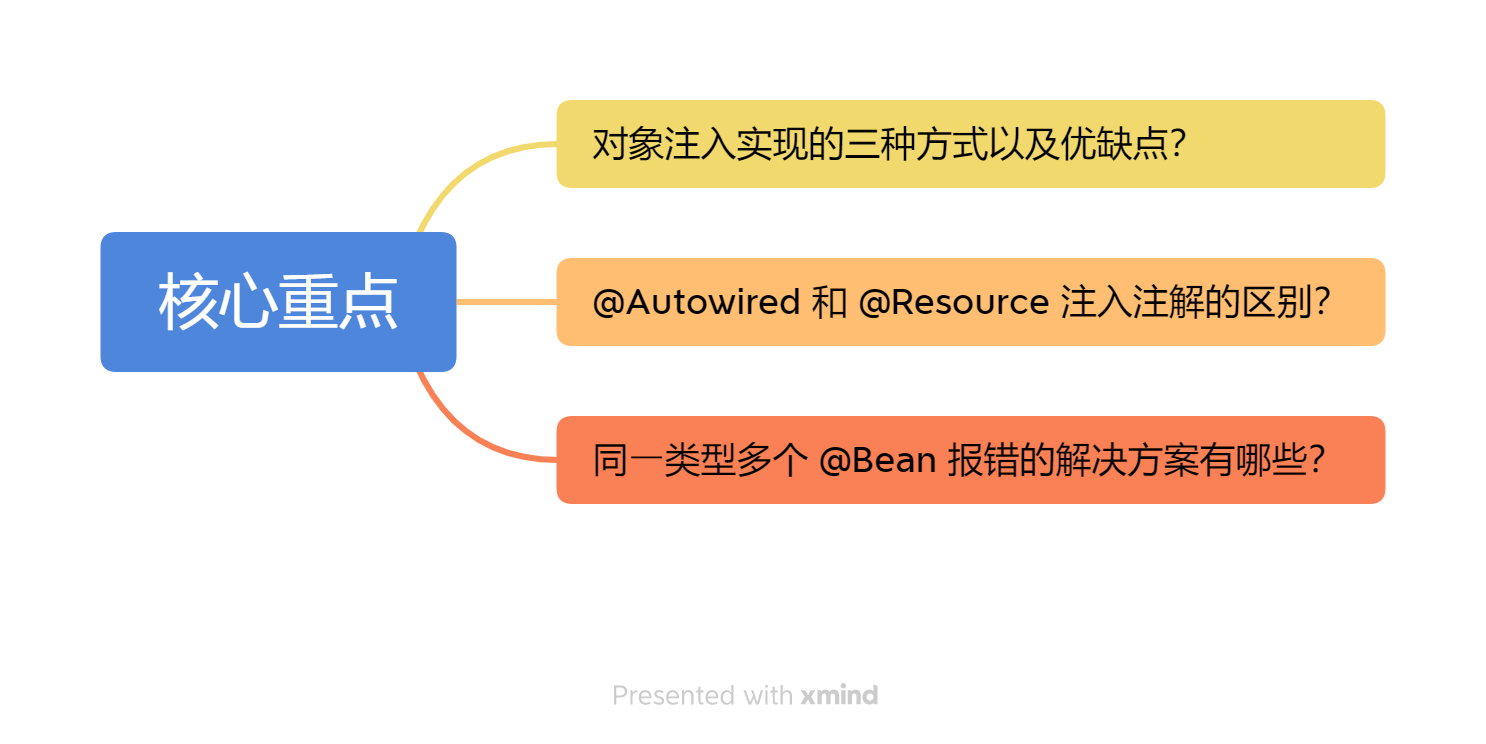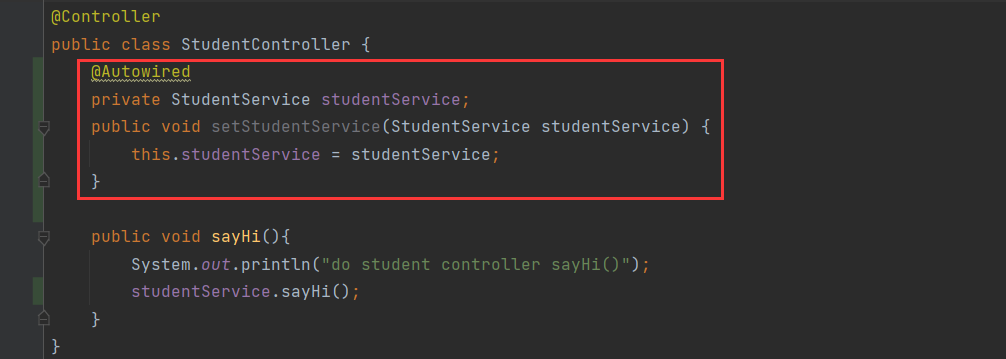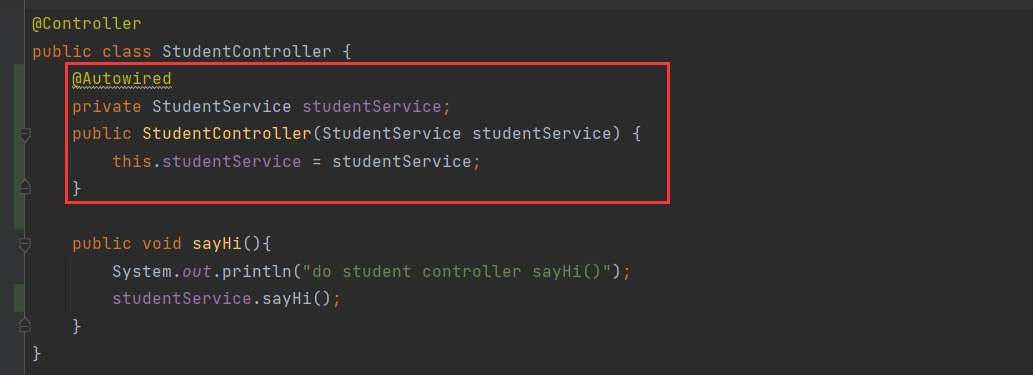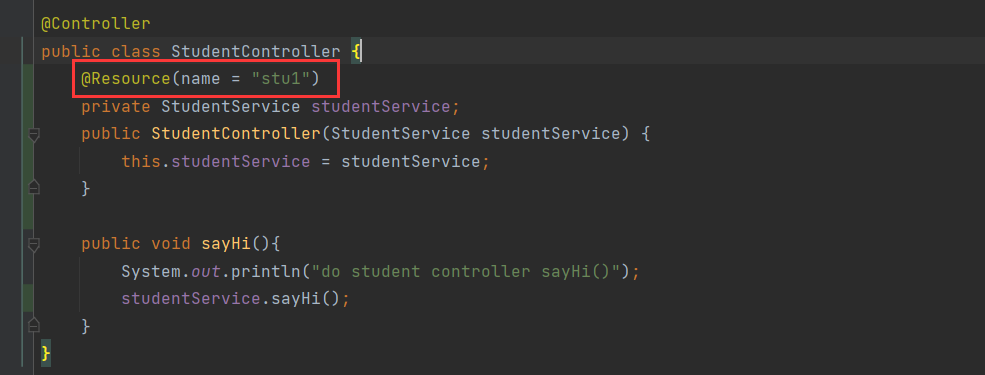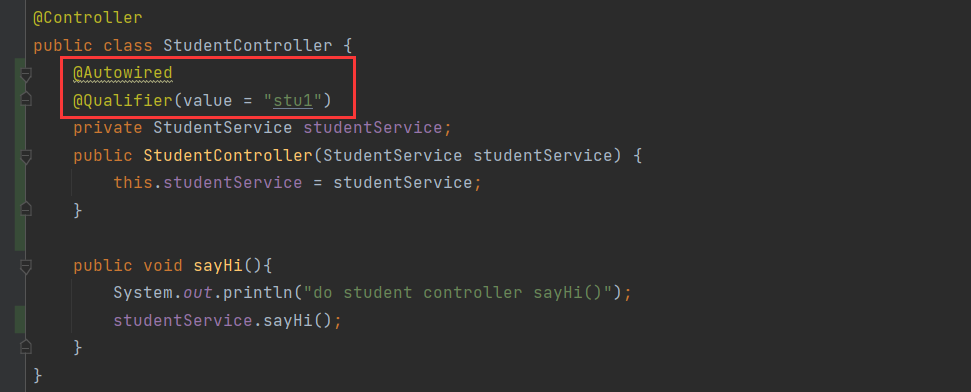【框架篇】对象注入的三种实现方式 |
您所在的位置:网站首页 › spring对象注入方式 › 【框架篇】对象注入的三种实现方式 |
【框架篇】对象注入的三种实现方式
|
对象注入也可被称为对象装配,是把Bean对象获取出来放到某个类中。 对象注入的实现方式有3种,分别为属性注入,Setter注入和构造方法注入。 为了更好地理解对象注入的实现方式,搞个实例来具体说明: 1.0,前期准备1,准备Service类 @Service public class StudentService { public void sayHi(){ System.out.println("do student service sayHi()"); } }示例问题:将 Service 类注入到 Controller 类中,对象注入实现: 1.1,属性注入1,方式对应实现的Controller 类代码: @Controller public class StudentController { //注入方式:属性注入 @Autowired private StudentService studentService; public void sayHi(){ System.out.println("do student controller sayHi()"); studentService.sayHi(); } }2,启动类实现代码: public class App { public static void main(String[] args) { //1,获取Spring上下文 ApplicationContext applicationContext = new ClassPathXmlApplicationContext("spring-config.xml"); //2,得到Bean对象 StudentController studentController = applicationContext.getBean("studentController",StudentController.class); //3,使用Bean对象 studentController.sayHi(); } }3,启动类执行结果:
1,方式对应实现的Controller 类代码: @Controller public class StudentController { private StudentService studentService; @Autowired public void setStudentService(StudentService studentService) { this.studentService = studentService; } public void sayHi(){ System.out.println("do student controller sayHi()"); studentService.sayHi(); } }2,启动类实现代码: public class App { public static void main(String[] args) { //1,获取Spring上下文 ApplicationContext applicationContext = new ClassPathXmlApplicationContext("spring-config.xml"); //2,得到Bean对象 StudentController studentController = applicationContext.getBean("studentController",StudentController.class); //3,使用Bean对象 studentController.sayHi(); } }3,启动类执行结果:
1,方式对应实现的Controller 类代码: @Controller public class StudentController { private StudentService studentService; @Autowired public StudentController(StudentService studentService) { this.studentService = studentService; } public void sayHi(){ System.out.println("do student controller sayHi()"); studentService.sayHi(); } }2,启动类实现代码: public class App { public static void main(String[] args) { //1,获取Spring上下文 ApplicationContext applicationContext = new ClassPathXmlApplicationContext("spring-config.xml"); //2,得到Bean对象 StudentController studentController = applicationContext.getBean("studentController",StudentController.class); //3,使用Bean对象 studentController.sayHi(); } }3,启动类执行结果:
1,方式实现代码:
2,方式优点: 实现简单,易于理解和维护3,方式缺点: 不能注入不可变对象【final 修饰的变量】通用性差,只适用于IoC容器,在非IoC框架中无效更容易违背单一设计原则 2.2,Setter注入1,方式实现代码:
2,方式优点: 符合单一设计原则【每个方法只传递一个对象】3,方式缺点: 不能注入不可变对象【final 修饰的变量】 使用Setter注入的对象可能被修改 2.3,构造方法注入1,方式实现代码:
注意:如果只有一个构造方法,那么 @Autowired 注解可以省略。 2,方式优点: 可以注入不可变对象【final 修饰的变量】 注入对象不会被改变【构造方法只执行一次】 注入对象会完全被初始化 通用性更好,可在IoC容器中使用,也可在非IoC中使用 3,方式缺点: 不符合单一设计原则【每个方法可传递多个对象】 三,对象注入中的问题 3.1,@Autowired 和 @Resource在进行类注入时,除了可以使用@Autowired注解之外,我们还可以使用@Resource注解进行注入。
@Autowired 和 @Resource 都是在 Spring 框架中用于注入依赖的注解,它们有以下区别: 来源不同: @Autowired 是 Spring 框架提供的注解,通过类型进行依赖注入。@Resource 是 JavaEE 定义的注解,通过名称进行依赖注入。 注入方式不同: @Autowired 默认按照类型匹配的方式进行注入,如果存在多个相同类型的实例,可以结合 @Qualifier 注解来指定具体实例。@Resource 默认按照名称匹配的方式进行注入,它支持使用 name 或 type 属性来指定名称或类型进行匹配。 支持的类型不同: @Autowired 支持通过构造方法注入、属性注入、Setter 注入的方式实现依赖注入。@Resource 支持通过属性注入、Setter 注入的方式实现依赖注入,不支持构造方法注入。 应用范围不同: @Autowired 主要用于 Spring 框架中的组件(如 Spring Bean)的依赖注入。@Resource 是 JavaEE 规范中的注解,它可以用于依赖注入和资源的获取,对于不依赖于 Spring 框架的应用也可以使用。 3.2,同⼀类型多个 @Bean 报错当出现多个 Bean 返回同⼀对象类型时,程序会报错。解决同一个类型,多个bean的解决方案有以下两个: 1,使用 @Resource(name="")
2,搭配 @Autowired 使用 @Qualifierr(value = "")
属性注入,Setter注入和构造方法注入是在依赖注入中常用的三种方式,它们各有优缺点: 1,属性注入方式:其实现简单,易于理解和维护,但是其不能注入不可变对象,只适用于IoC容器,并且违反单一设计原则的概率大。 2,Setter注入方式:其符合单一设计原则,但是其不能注入不可变对象,并且使用Setter注入的对象可能被修改。 3,构造方法注入方式:其可以注入不可变对象,注入的对象不能被改变,保证注入对象完全被初始化,并且具有通用性,但是其不符合单一设计原则。 注意:在上述的三种对象注入的实现方式中,构造方法注入是Spring推荐的注入方式。 思考:为什么构造方法可以注入不可变变量,而属性注入和Setter注入却不行呢? 解答:在 Java 中,被final修饰的对象,要么直接进行赋值,要么就在构造方法中进行赋值,两种情况必须满足一个,否则方式报错。 2,@Autowired 和 @Resource 注入注解的区别?@Autowired 和 @Resource 都是在 Spring 框架中用于注入依赖的注解,它们有以下区别: 1,来源不同:@Autowired 是 Spring 框架提供的注解,而@Resource 是 JavaEE 定义的注解。 2,注入方式不同:@Autowired 默认按照类型匹配的方式进行注入,而@Resource 默认按照名称匹配的方式进行注入。 3,支持的类型不同:@Resource 支持通过属性注入、Setter 注入的方式实现依赖注入,不支持构造方法注入,而@Autowired 支持。 4,应用范围不同:@Autowired 主要用于 Spring 框架中的组件的依赖注入,而@Resource对于不依赖于 Spring 框架的应用也可使用。 3,同⼀类型多个 @Bean 报错的解决方案有哪些?解决同一个类型 @Bean 报错的解决方案有以下两个: 使用 @Resource(name="")使用 @Qualifierr(value = "") 【搭配@Autowired使用】 结语这就是本期博客的全部内容啦!如果有什么其他的问题无法自己解决,可以在评论区留言哦! 最后,如果你觉得这篇文章写的还不错的话或者有所收获的话,麻烦小伙伴们动动你们的小手,给个三连呗(点赞👍,评论✍,收藏📖),多多支持一下!各位的支持是我最大的动力,后期不断更新优质的内容来帮助大家,一起进步。那我们下期见!
|
【本文地址】

